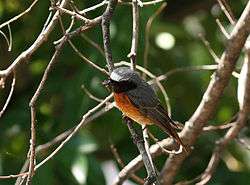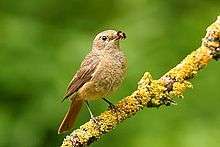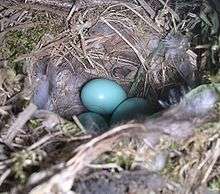Common redstart
| Common redstart | |
|---|---|
 | |
| Male | |
| Scientific classification | |
| Kingdom: | Animalia |
| Phylum: | Chordata |
| Class: | Aves |
| Order: | Passeriformes |
| Family: | Muscicapidae |
| Genus: | Phoenicurus |
| Species: | P. phoenicurus |
| Binomial name | |
| Phoenicurus phoenicurus (Linnaeus, 1758) | |
| Subspecies | |
Common redstart
Southeastern common redstart | |
The common redstart (Phoenicurus phoenicurus), or often simply redstart, is a small passerine bird in the redstart genus Phoenicurus. Like its relatives, it was formerly classed as a member of the thrush family, (Turdidae), but is now known to be an Old World flycatcher (family Muscicapidae).
Taxonomy and systematics
The first formal description of the common redstart was by the Swedish naturalist Carl Linnaeus in 1758 in the tenth edition of his Systema Naturae under the binomial name Motacilla phoenicurus.[2] The genus Phoenicurus was introduced by the English naturalist Thomas Forster in 1817.[3] The genus and species name phoenicurus is from Ancient Greek phoinix, "red", and -ouros -"tailed".[4]
Two subspecies are accepted. The nominate P. p. phoenicurus is found all over Europe and reaches into Siberia. To the southeast, subspecies P. p. samamisicus is found from the Crimean Peninsula through Turkey, the Middle East, and into Central Asia. It is slightly smaller than P. p. phoenicurus and in adult males has white outer webs in the remiges to some extent, forming a pale to whitish wing-patch similar to the one seen in black redstart and Daurian redstart. This patch is also present but less conspicuous in immature males, and sometimes in adult females. The subspecies intergrade widely in Turkey and the southern Balkans.[5][6]
The closest genetic relative of the common redstart may be the Moussier's redstart, though incomplete sampling of the genus gives some uncertainty to this.[7] Its ancestors were apparently the first redstarts to spread to Europe; they seem to have diverged from the black redstart group about 3 mya, during the Piacenzian.[8] Genetically, common and black redstarts are still fairly compatible and can produce hybrids that appear to be healthy and fertile, but they are separated by different behaviour and ecological requirements so hybrids are very rare in nature.[9]
Description
The common redstart shows some affinity to the European robin in many of its habits and actions. It has the same general carriage, and chat-like behaviour, and is the same length at 13–14.5 cm long but slightly slimmer and not quite as heavy, weighing 11–23 g. The orange-red tail, from which it and other redstarts get their names ("start" is an old word for "tail"), is frequently quivered. Among common European birds, only the black redstart (Phoenicurus ochrurus) has a similarly coloured tail.[5][6]

The male in summer has a slate-grey head and upperparts, except the rump and tail, which, like the flanks, underwing coverts and axillaries are orange-chestnut. The forehead is white; the sides of the face and throat are black. The wings and the two central tail feathers are brown, the other tail feathers bright orange-red. The orange on the flanks shades to almost white on the belly. The bill and legs are black. In autumn, pale feather fringes on the body feathering obscures the colours of the male, giving it a washed-out appearance. The female is browner, with paler underparts; it lacks the black and slate, and the throat is whitish.
Distribution and habitat
Common redstarts prefer open mature birch and oak woodland with a high horizontal visibility and low amounts of shrub and understorey especially where the trees are old enough to have holes suitable for its nest. They prefer to nest on the edge of woodland clearings. In Britain it occurs primarily in upland areas less affected by agricultural intensification, but further east in Europe also commonly in lowland areas, including parks and old gardens in urban areas. They nest in natural tree holes, so dead trees or those with dead limbs are beneficial to the species; nestboxes are sometimes used. A high cover of moss and lichen is also preferred. They also use mature open conifer woodland, particularly in the north of the breeding range. Management to thin out the trees is thus favoured.[5][6]
In England, where it has declined by 55% in the past 25 years, the Forestry Commission offers grants under a scheme called England's Woodland Improvement Grant (EWIG); as does Natural Englands Environmental Stewardship Scheme.
Behaviour and ecology

.jpg)
It is a summer visitor throughout most of Europe and western Asia (east to Lake Baikal), and also in northwest Africa in Morocco. It winters in central Africa and Arabia, south of the Sahara Desert but north of the Equator, from Senegal east to Yemen. It is widespread as a breeding bird in Great Britain, particularly in upland broadleaf woodlands and hedgerow trees, but in Ireland it is very local, and may not breed every year.
The males first arrive in early to mid April,[10] often a few days in advance of the females. Five or six light blue eggs are laid during May, with a second brood in mid summer in the south of the breeding range. It departs for Africa between mid-August and early October. It often feeds like a flycatcher, making aerial sallies after passing insects, and most of its food consists of winged insects. The call is chat-like and the alarm a plaintive single note, wheet, like that of many other chats.[5]
The male’s song is similar to that of the Robin, but never more than a prelude, since it has an unfinished, feeble ending.
References
- ↑ BirdLife International (2012). "Phoenicurus phoenicurus". IUCN Red List of Threatened Species. Version 2013.2. International Union for Conservation of Nature. Retrieved 26 November 2013.
- ↑ Linnaeus, C. (1758). Systema Naturæ per regna tria naturae, secundum classes, ordines, genera, species, cum characteribus, differentiis, synonymis, locis, Volume 1 (in Latin) (10th ed.). Holmiae:Laurentii Salvii. p. 187.
- ↑ Forster, Thomas (1817). A Synoptical Catalogue of British Birds. London: Nichols, Son, and Bentley. p. 53.
- ↑ Jobling, James A. (2010). The Helm Dictionary of Scientific Bird Names. London, United Kingdom: Christopher Helm. p. 304. ISBN 978-1-4081-2501-4..
- 1 2 3 4 Hoyo, J. del; et al., eds. (2005). Handbook of the Birds of the World, vol. 10. Barcelona: Lynx Edicions. p. 771. ISBN 84-87334-72-5.
- 1 2 3 Snow, D. W. & Perrins, C. M. (1998). The Birds of the Western Palearctic (Concise ed.). Oxford: Oxford University Press. ISBN 0-19-854099-X.
- ↑ Sangster, G.; Alström, P.; Forsmark, E.; Olsson, U. (2010). "Multi-locus phylogenetic analysis of Old World chats and flycatchers reveals extensive paraphyly at family, subfamily and genus level (Aves: Muscicapidae)" (PDF). Molecular Phylogenetics and Evolution. 57: 380–392. PMID 20656044. doi:10.1016/j.ympev.2010.07.008.
- ↑ Ertan, K. T. (2006). The Evolutionary History of Eurasian Redstarts "Phoenicurus". Acta Zoologica Sinica 52 (Supplement): 310–313. PDF fulltext Archived 2014-05-25 at the Wayback Machine.
- ↑ Grosch, Kai (2004). Hybridization Between the Redstart Phoenicurus phoenicurus and Black Redstart P. ochruros, and the Effect on Habitat Exploitation. J. Avian Biol. 35 (3): 217-223. doi:10.1111/j.0908-8857.2004.03128.x (HTML abstract)
- ↑ "Redstart". RSPB.
External links
| Wikimedia Commons has media related to Phoenicurus phoenicurus. |
- Common redstart videos, photos & sounds on the Internet Bird Collection
- Ageing and sexing (PDF; 3.5 MB) by Javier Blasco-Zumeta & Gerd-Michael Heinze
- RSPB Website Description
- Common redstart Images
